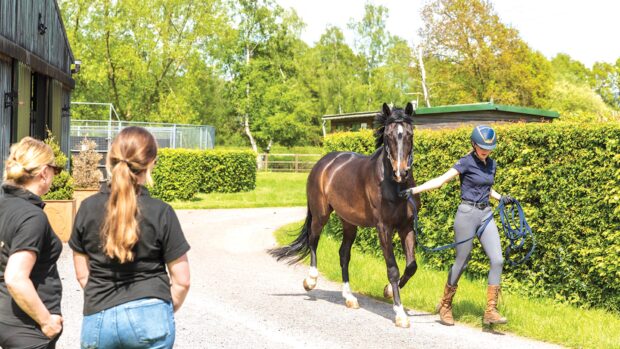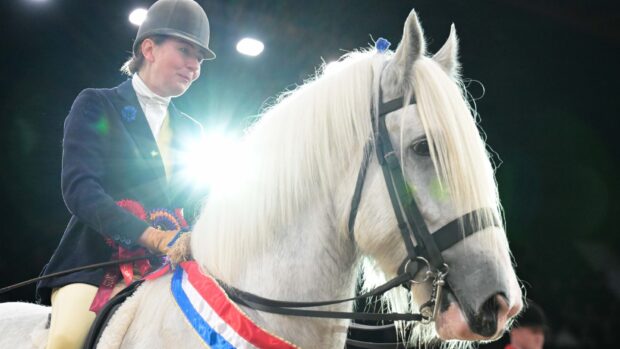Want to buy an Exmoor pony? Then this guide on what to look for and where to search is a good place to start.
What is an Exmoor pony?
The Exmoor pony is one of Britain’s oldest breed of native pony. The Exmoor pony is a rare native breed recognised by the Rare Breed Survival Trust and is listed in their watchlist under priority.
The preferred height range of Exmoors is:
- Stallions and geldings can stand up to 12.3hh, from 11.3hh
- Mares can stand up to 12.2hh, 11.2hh
The Exmoor Pony Society (EPS) was founded in 1921.
The EPS states that: “Exmoor ponies are versatile, adaptable, very strong for their size and able to turn their hooves to a wide variety of activities. Historically, the Exmoor pony was used by the hill farmers to undertake all kinds of work from being ridden for shepherding to being used in harness for ploughing, harrowing, taking feed to stock and the farmer’s family to market and church. Ponies from wild herds were gathered and then trained to pull the carts and chariots of the Celtic settlers. The Doomsday book contains the first written evidence of ponies on Exmoor, when it was a designated Royal Forest. Records from the 1500s onwards reveal that the equine population varied in numbers rising to about 1,000 at times. Non-Exmoor mares came to the moor to join the indigenous British Hill Pony type stock but it is thought that the wardens ran native stallions.”
There are approximately 500 breeding mares and 100 licensed, registered stallions in any given period of five years producing between 100-150 foals per year.
Foals are bred into the free-living herds on Exmoor – the home of the Exmoor pony – and also in in-ground and free-living situations throughout the UK, Europe and North America.
All Exmoor pony foals are inspected each year and registered into Section 1 or Section X of the EPS studbook in accordance with EU/DEFRA legislation and the Rules of the EPS.
Each herd is assigned a number and then each foal is assigned a number in that herd – this makes up the registration number for the pony.
The EPS provides the following breed standard:
- General appearance: Definite “pony” character; hard and strong; vigorous and alert and symmetrical in appearance; mealy muzzle; prominent hooded toad eye
- Head and neck: ears short, thick and pointed; clean cut face; wide forehead, eyes large, wide apart & prominent with well defined fleshy hood and pale colouration outlining the eyes (Toad Eyes); wide nostrils; mealy muzzle; clean throat; good length of rein.
- Shoulders: clean, fine at top, well laid back.
- Chest: deep and wide between and behind forelegs; Ribs long, deep, well sprung and wide apart.
- Back: level; broad and level across loins; tail neatly set in.
- Legs: clean & short, with neat uniformly dark hoof walls; forelegs straight, well apart and squarely set; hind legs well apart, nearly perpendicular from hock to fetlock with point of hock in line with pelvis bone; wide curve from flank to hock joint; legs free in motion with no tendency to sweep or turn.
- Action: straight and smooth, without exaggerated action.
- Coat: summer – close, hard and bright. Winter – a double-layered dense coat with an under insulating layer of fine, springy hair and an outer waterproofing layer of hard, greasy hair.
- Colour: bay, brown or dun, with black points; mealy colour on muzzle, round eyes and inside flanks; no white markings anywhere.
- Quality: alert expression and general poise indicating balance and symmetry of movement; flat clean bone.
What should I look for in an Exmoor?
Jackie Webb has been breeding Exmoor ponies under the Blackthorn prefix since 1978. She is also on a number of judging panels, including NPS and BSPS, and Exmoor, Connemara and New Forest breed society panels.
Influential Exmoor stallions she has owned or bred include Dunkery Buzzard, Blackthorn Hawkwind, Siskin and Blackthorn Sea Poacher. Siskin was a three-time Horse of the Year Show (HOYS) in-hand finalist, and Sea Poacher qualified for HOYS numerous times, including with Laura Collett who campaigned him in working hunter classes. Blackthorn Poldark won at Hickstead in 2023 with Jess Talbot, and Blackthorn Blush Rose won at HOYS twice with Katy Marriott-Payne.
“The pony has to shout Exmoor at you, which most of them do,” says Jackie. “An Exmoor is usually instantly recognisable.
“An Exmoor should be a well-made pony with good limbs and bone. It must move, too, and these days many good ridden ponies do have movement and are able to be schooled similarly to the other breeds you see out and about on the circuit. Once upon a time, not many people showed Exmoors, but they are increasingly popular, which has been positive for the breed.
“Mealy markings are important. I liked a well-marked pony, with obvious mealy markings. Darker ponies don’t have obvious markings and at certain times in the year they can lose their markings completely, especially if they are rugged during show season.
“A good Exmoor should have a bold eye and small pony ears.
“Our breeding stock should be as good quality as ridden ponies, however you arguably might want a pony with more scope for the ridden job.”
What can I do with an Exmoor?
Exmoors are a versatile breed and they can usually perform in multiple disciplines. They are hardy and tough, and they are often brave and nimble. They are a good choice as a working family pony as they can live out and require little maintenance.
Due to their stamp and size, Exmoors make ideal mounts for small adults as well as capable children.
Exmoors contend small breeds M&M ridden classes and they jump in either 122cm or 133cm working hunter pony classes. Many Exmoors jump well and the breed is also increasingly visible in the mini circuit, with representatives contending both lead rein and first ridden classes with success.
If I buy an Exmoor, will it suit me?
It depends on the pony, and your riding abilities as well as what you wish to do with your pony.
Exmoors are known for being a quirky breed that isn’t suitable for everyone, however Jackie says it’s very much a case of horses for courses: “They are known for their quirks, but they are usually highly intelligent which makes them not suitable for everyone. They’re always one step ahead of you, and people can mistake that for them being stubborn.
“Today, you see lots of Exmoor contending first ridden and lead rein classes, so it depends on the temperament of the individual pony. It depends on how they are educated, too. If you get a pony that is wild from the moor, then he will take a lot more work to get going compared to a pony that has been handled from the off.”
Where should I buy an Exmoor pony from?
“If you want to buy an Exmoor for the ridden job, then I’d suggest taking your time to go to multiple breeders and have a real good look around,” Jackie advises. “The more ponies you can look at the better; this helps you get your eye in.
“If you’re wanting a foal and are happy to wait for it to mature and grow, you can go to the breeders who run ponies on the moor. There really isn’t anything more rewarding than bringing one up yourself. But, if you’re looking for an older pony to bring on sooner than I suggest going to the up-country breeders as these ponies have usually been handled more. Be aware of your own capabilities as not everyone has the experience to bring on a wild Exmoor foal!”
How much should I expect to pay for an Exmoor?
Like all native breeds, Exmoors vary in price depending on temperament, age, competition record and other factors.
“There are cheap ponies around, but, like in any breed, the better ridden ponies are fetching higher prices,” says Jackie. “These days, a good foal can easily make between £500 to £1000.”
I’ve agreed to buy an Exmoor pony, now what?
It is time to organise a pre-purchase vetting, something that is strongly recommended. If the pony is for a child, perhaps asking for a trial period would be sensible, but not all sellers will agree to this.
It’s important to let the vet know prior to the vetting what you intend to use the pony for so they can assess it accordingly.
If you tell the vet that you want the pony for the show ring, they should hopefully inform you of any blemishes or conformational faults which could impact its future career, even if they don’t impact its soundness or performance.
Do note that if you are buying an Exmoor off the hill, it will be unlikely that you will have the pony vetted as it could have had little handling.
“It depends on what you are paying for an Exmoor, too,” says Jackie. “But for peace of mind you could always get an older pony checked over by the vet.”
For more information, you can read H&H’s ultimate guide to buying a horse.
- To stay up to date with all the breaking news from major shows throughout the season, subscribe to the Horse & Hound website
You may also be interested in:

Subscribe to Horse & Hound magazine today – and enjoy unlimited website access all year round

How can I buy my perfect Connemara pony?

On the hunt for a Welsh section A pony? Then you need to read this first…




